When we think about the makeup of a marketing unit within the walls (or budgets) of an independent or private school, we often consider four key players: a head of school (including here: a board of trustees), a director of advancement, a director of admissions, and a director of marketing. As each school is structured differently and may have different combinations of these key players, one theme tends to hold true for all: marketing matters to everyone, and so does the data that can be extracted by relevant digital marketing operations.
Your job as a marketer is to determine which data points are most important to evaluate, to organize the data points in one easy-to-digest place, and to justify why that data is relevant and valuable for your teammates to succeed. In doing so, you’ll create long-lasting actionable strategies while elevating your role as one who bridges gaps in understanding the data to raise marketing awareness across all stakeholders— a win-win situation for all.
So how do you break down the data for each key player in a way that matters to them?
1. Find your shared interests and common goals
If you’re a designated marketer at your institution, one of your goals may be to increase the duration of time a visitor spends on your website. This would tell you that the content they’re absorbing is relevant, and that they’re interested. This is measurable data that can be extracted from your website analytics and shared with your head of school or board.
Other people on your team might have goals that sound different. For example, your admissions officer’s goal may be to increase the number of applications they are receiving prior to your school’s application deadline. That applicant’s journey started somewhere… At some point, a person interested in your school would have had information put in front of them by your marketing teammates - likely multiple times - and it was effective and relevant enough that it piqued their curiosity, bringing them farther into the journey and ultimately getting them ready to apply.
In this way, your goal and theirs are in perfect alignment and you can work together to increase your page visit duration on key admissions destinations online.

2. Highlight what they care about most
Your head of school might care most about improving the school’s reputation within the community, and knowing that your marketing messages are ‘getting out there’ effectively. You’ll want to highlight data that’s focused on reach and engagement.
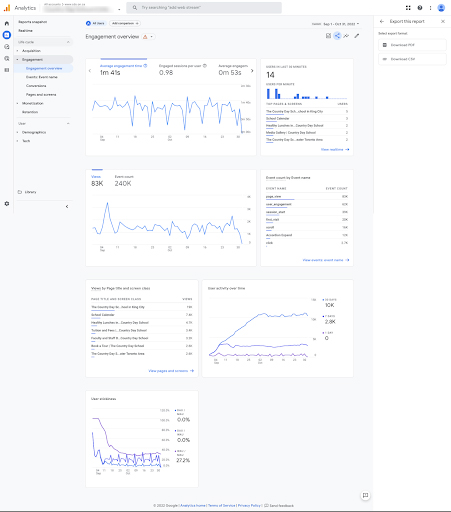
An example report with user engagement data, including average engagement rate, user stickiness, top pages by views and engagement over time.
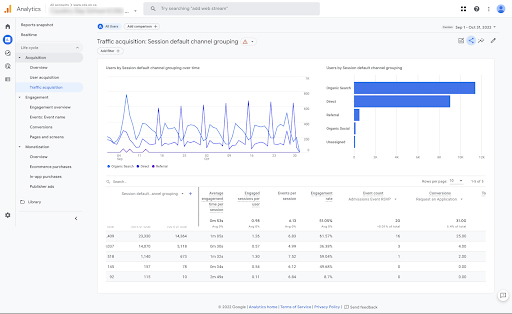
An example report with traffic acquisition data, showing which channels drove Admissions event registrations and request for application form submissions.
3. Make sure that everyone trusts the data
Not everyone cares to learn how the sausage is made (so to speak), but it is important that each stakeholder understands enough about your marketing data sources to trust them. A little bit of education here can go a long way - and so can an initial investment in your data tracking and measurement, along with regular ongoing maintenance. (An external partner like Metric Marketing can help with this. Check out our blog on creating a measurement plan here!)
One critical step you can - and should - take is to make sure your marketing data aligns across multiple sources. For example, you may be tracking a goal conversion on your website for folks to hit the “inquire” button to your CRM platform - but if your admissions teammates don’t see the same number of inquiries coming in on their end, you know there’s an issue to solve. Ask yourself: what conclusion can we draw from these inconsistencies? (hint: maybe your inquiry form is asking too many questions and it’s stopping prospective families from continuing! See? You’re already coming to conclusions and giving your admissions staff an action item to push them further towards their goal!)
4. Make your data transparent and accessible
Choose a tool or a platform that may help your colleagues understand the data you’re always talking about so that it is accessible and easy to reference. Investing the time into creating an internal “dashboard” (try Google Data Studio) may help in reducing one-off questions or multiple meetings with different stakeholders that may be repeating the same information.
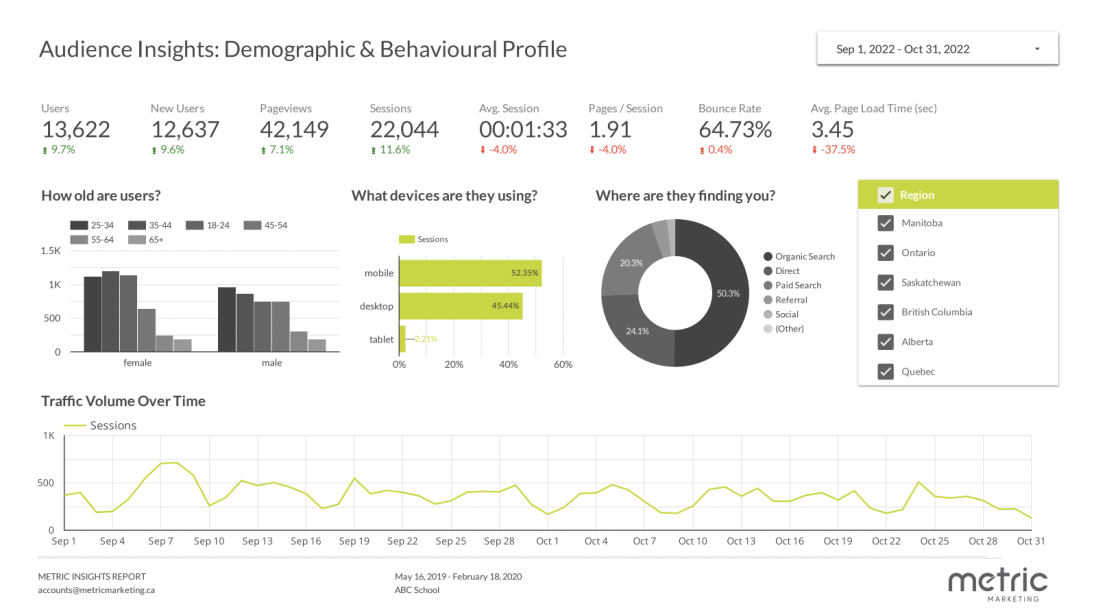
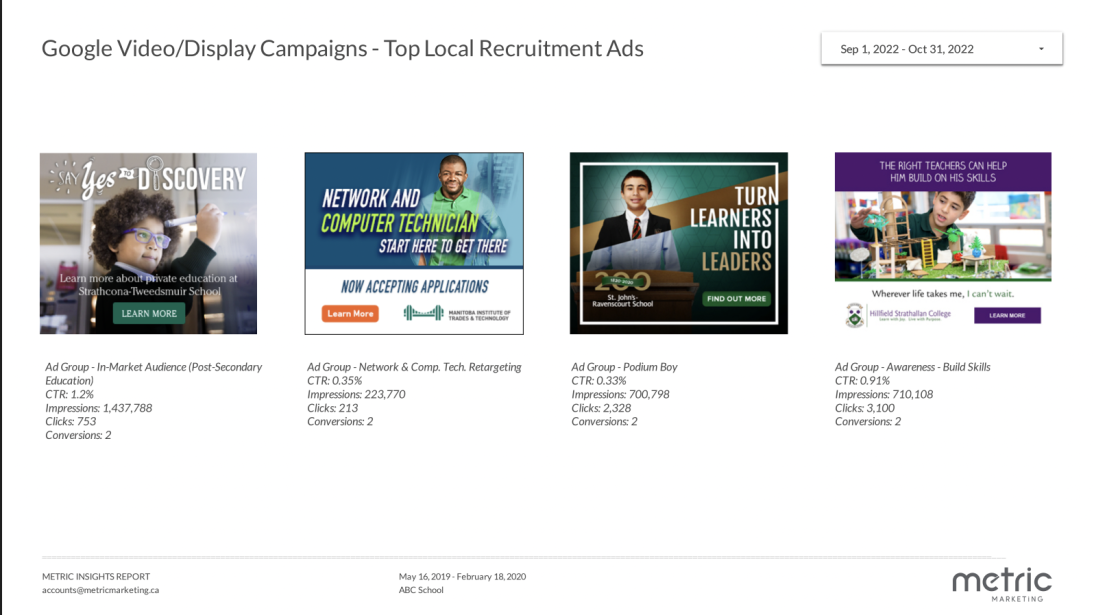
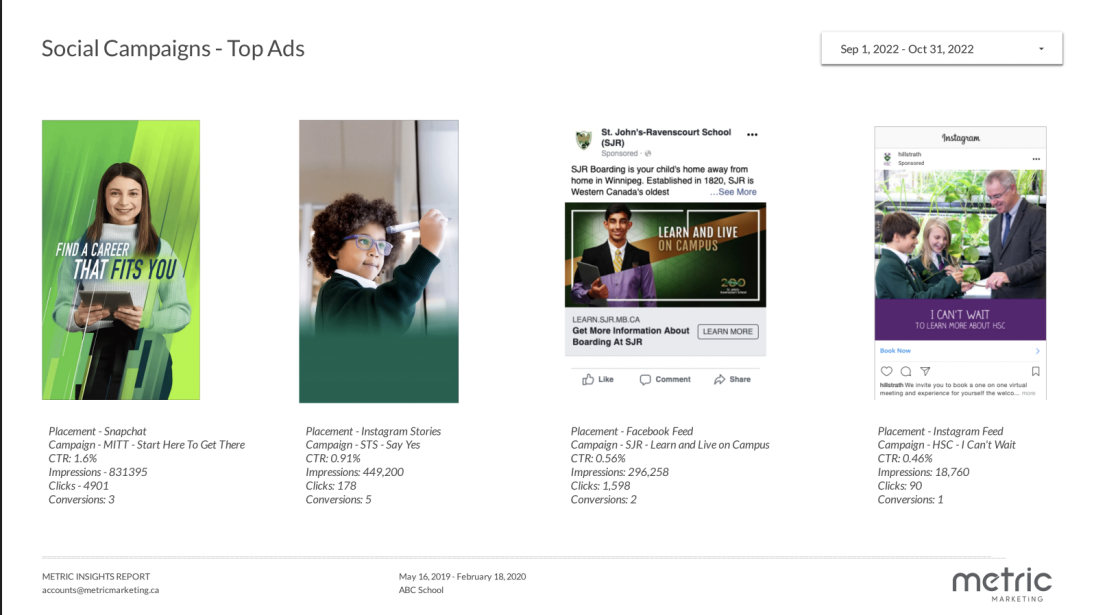
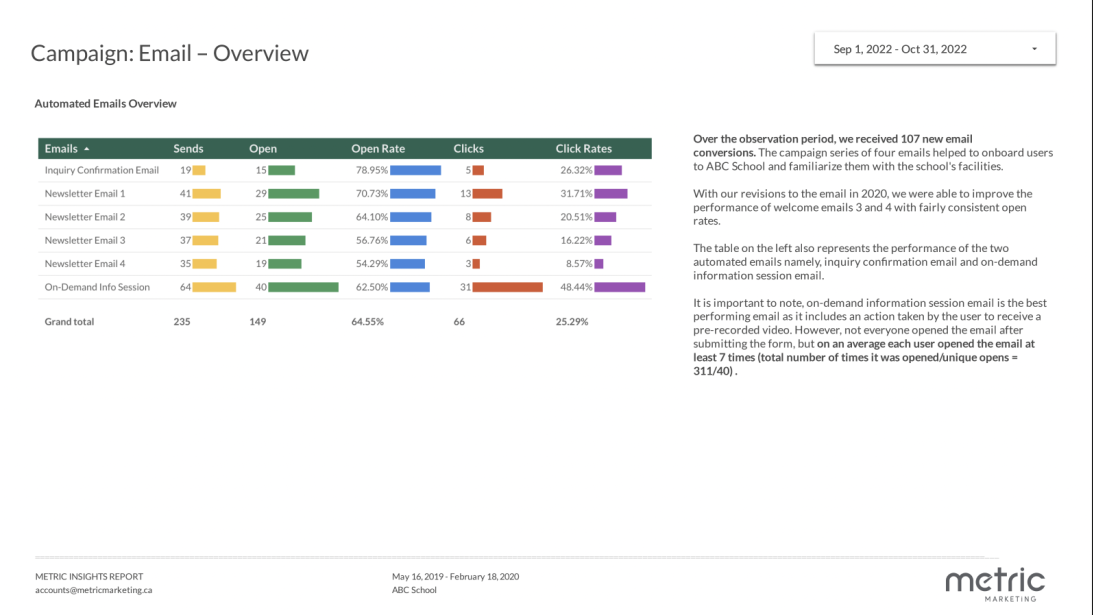
These excerpts from a Metric Insight Report provide data that may be relevant to various stakeholders; granular demographic and behavioral website data, geographic acquisition stats and automated Admissions newsletter data.
Tip: Prioritize time in your schedule to refresh the data consistently so that timely decisions can be made. If consistency is difficult to implement, prioritize the times before and immediately following events, application deadlines, or school fairs as benchmarks to start.
5. Tell a story with your data
Just like the inquiry example above, all measurable data can be used to spark self-reflective questions to draw conclusions that can assist in better decision-making. The word “data” in and of itself can spark discomfort in your teammates who don’t respond well to excel sheets and percentage signs. Presenting measurable data in the form of a narrative can help your teammates to better understand it in a way that guides them to ask relevant questions to consistently reflect and adjust their next steps to better serve their audience. After all, it is called a “customer journey”— why not take your colleagues on a journey to understanding the string of patterns in your data?
As stated in our recent study with NAIS, “Marketing looks at the entire journey a family takes with the school, not just at the success of individual tactics standing alone. The journey—from becoming aware of your brand for the first time to taking an action that is deemed a conversion (inquiring, signing up for an open house, starting the application process etc.) to enrollment—is long and well-researched. Your reporting should understand this journey and all of the different components that work together to drive a conversion.” (Read more about our State of Independent School Marketing Report with NAIS here.)
You can consistently add value to your team by being the first person to ask - and answer - the question of “so what?” whenever you’re talking about data. Creating actions from insights helps ensure that everyone in your organization will come to value marketing data (and it basically turns you into a superhero).
Ready to get started?
Common questions Admissions can ask based on digital marketing data:
Do our families need more personalized attention?
Are we answering so many questions in our content that our audiences have no need to reach out?
What is discouraging a family from not filling out an inquiry form?
Are we offering the right events based on what our families are looking for?
Do we need to pivot in offering (more/less) (online/in-person) events?
Common questions Marketing can ask based on digital marketing data:
Are we reaching our target audiences effectively?
Are visitors to the website interacting with our pages/CTAs?
Can we be introducing more image/video-centered content?
How many times does an audience member require exposure to our content before making an actionable decision?
Which platforms are yielding the most success in our trackable goal completions?
If you’re feeling unsure about the data you’re pulling, you’re not sure where to start, you feel you’re missing important information, or if you want a partner in your corner to work with you on all of this - talk to Metric! We’d love to talk data with you.
At Metric Marketing, we develop measurable and practical strategies to help private and independent schools like yours to make the most of your marketing efforts. We'd love to discuss your private school's marketing requirements with you. Contact us today to speak with our marketing professionals or sign up to receive more marketing tips in your inbox.





